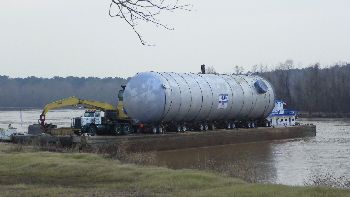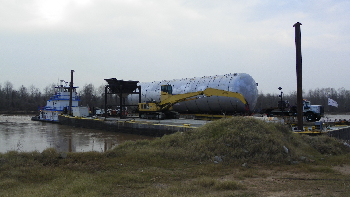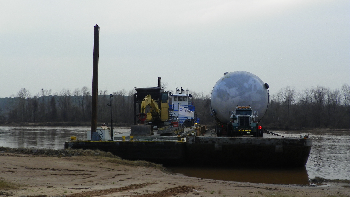Recent News
|
Barge traffic on the Red: M6 incinerator arrives at Natchitoches Parish PortAn M6 incinerator, used to destroy potentially hazardous chemicals, made it up the Red River last week after traveling down the Arkansas and Mississippi Rivers. The unit departed from the Port of Catoosa in Tulsa, OK and arrived by barge at the Natchitoches Parish Port after encountering several delays from elevated water levels on the Arkansas River. Officials had initially projected nearly three weeks to complete the trip, but it ended up taking almost 6 weeks. “It takes a lot of planning and logistics between all involved groups to make something like this happen,” said Lorraine Hyde, General Logistics Manager for Terral River Service. “The Arkansas River had some flooding which delayed our vessel’s initial departure, but water-borne travel is still one of the safest and most efficient modes of transportation.” The incinerator measured 180 feet long by 27.5 feet wide and weighed 500,000 pounds. It was the largest structure of its kind to be transported on the Red River. Ken Guidry, Executive Director of the Red River Waterway Commission, added “We’re always happy to see barge activity on the river. It’s a perfect testament to the positive impacts and benefits of water-borne transportation.” There are 5 public ports on the Red River Waterway that offer commercial space and transportation services to businesses. These ports, most of which are multi-modal facilities, have contributed much in the way of expanded industry and economic development. “The Natchitoches Parish Port is proud to have had a part in the journey of the incinerator,” said Port Director Robert Breedlove. “This further solidifies the Port as a multi-modal facility.” The incinerator completed the remainder of its journey by truck to its final destination at Camp Minden. Jimmy Jernigan, Director of Operations for J&B Heavy Haul in Oklahoma, believes the Natchitoches Parish Port was the most logical and ideal choice as a destination. “We were easily able to access the Natchitoches Port because of its location on the east side of the Red River. It was also in close proximity to the unit’s final destination.” |



